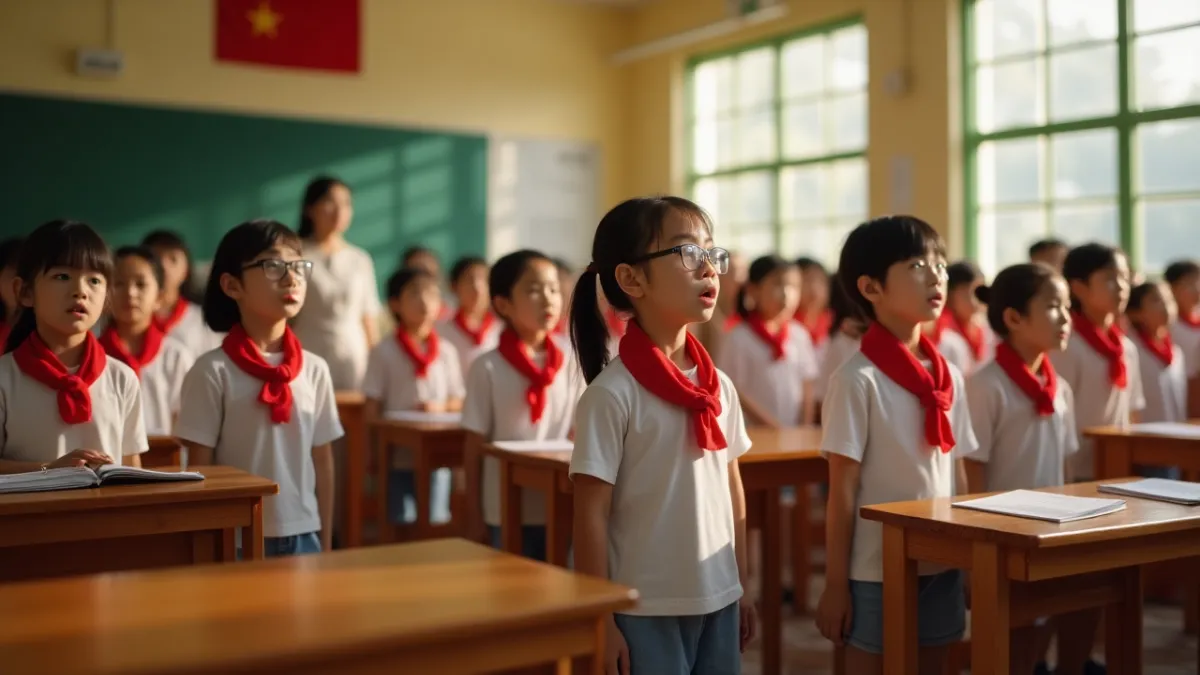In the rugged highlands of Thanh Hoa Province, schools grapple with a persistent lack of essential teaching equipment, a microcosm of broader challenges facing Vietnam’s education sector. Despite significant strides in infrastructure investment, a recent report from the Ministry of Education and Training (MoET) reveals deep-seated gaps that threaten the quality of education and the rollout of critical reforms. As the nation strives to modernize its schools, the disparities between urban and remote areas underscore an urgent need for coordinated action and innovative funding solutions.
Progress Amidst Persistent Shortfalls
Vietnam has made notable advancements in its education infrastructure over recent years. According to the MoET report, there are over 618,280 classrooms across public preschools and general education institutions nationwide, with 89.6 percent now classified as permanent structures. At the primary level, classroom availability largely supports full-day teaching, a significant achievement in ensuring access. Investments have also bolstered supporting facilities—libraries, specialized subject classrooms, staff accommodations, canteens, dormitories, and sanitation systems—reflecting a commitment to holistic school environments.
Local efforts have contributed to this progress, with communities modernizing facilities and phasing out makeshift or dilapidated classrooms. Student-to-teacher ratios now align with national regulations in many areas, and some schools have turned to locally produced or self-repaired teaching tools to bypass procurement delays. Additionally, the government has introduced preferential policies on land, tax, and credit to mobilize private resources, particularly for non-public institutions, signaling an openness to alternative funding models.
Yet, beneath these gains lie systemic issues. Equipment investment remains fragmented, with many provinces failing to adopt standardized norms for specialized facilities. Budget constraints, outdated pricing models, lengthy appraisal processes, and cumbersome procurement procedures often delay the acquisition of even basic teaching tools. Some agencies and businesses hesitate to engage in procurement due to accountability concerns, further stalling progress. In Thanh Hoa’s mountainous regions, for instance, the absence of essential equipment continues to hinder effective teaching, a stark reminder of the uneven distribution of resources.
Financial Constraints and Budgetary Imbalances
Funding lies at the heart of Vietnam’s education challenges. From 2013 to 2024, state budget spending on education consistently fell below the mandated threshold of 20 percent. Of the allocated funds, 83.4 percent went toward recurrent expenditures—salaries, operational costs, and maintenance—leaving a mere 17.6 percent for capital investments such as school construction and renovation. This imbalance has left many schools, particularly in remote areas, unable to upgrade facilities or meet growing demand.
Local governance exacerbates the issue. Some provinces have not prioritized education in their budgets, relying heavily on central government allocations. In certain cases, funds have even been returned due to inefficiencies in disbursement, highlighting a lack of capacity or strategic planning at the local level. The MoET report estimates a need for 75,380 new classrooms to reinforce existing facilities and an additional 66,799 to comply with class-size regulations. For the 2018 General Education Curriculum to be fully implemented, schools require over a thousand subject-specific classrooms, libraries, teacher housing units, and sets of basic equipment.
For boarding and semi-boarding students in remote areas, the needs are even more acute. Provinces report a demand for over 39,000 dormitory rooms, 2,000 kitchens, and various support facilities, including sanitation systems and water supply. These figures paint a picture of an education system stretched thin, particularly in disadvantaged regions where infrastructure gaps directly impact student outcomes.
Policy Responses and Future Plans
Recognizing these challenges, MoET is pushing for a comprehensive overhaul of Vietnam’s education infrastructure. Trần Thanh Đạm, director of the Planning and Finance Department, emphasized the importance of reorganizing school networks based on local needs rather than arbitrary staff reductions or institutional mergers. Land planning must prioritize education, especially in urban, high-density, and resettlement areas, to ensure space for future growth.
MoET is also advocating for clear standards on classroom space and teaching equipment, tailored to local conditions. Infrastructure investments should focus on meeting minimum teaching requirements, particularly in underserved regions, with an emphasis on practical assessments over ambitious but unfeasible projects. The ministry encourages the use of locally produced teaching tools, provided they meet quality benchmarks, as a cost-effective solution to equipment shortages.
Procurement processes are under scrutiny as well. Provinces are urged to align purchases with the 2018 curriculum rollout, reviewing existing equipment to avoid duplication and prioritizing essential needs over modern but non-critical tools. Completing purchases before the school year begins is a key directive, aimed at minimizing disruptions to teaching schedules. Moreover, MoET stresses the importance of increased local budget allocations and better integration of education investments into national target programs, alongside continued efforts to mobilize private and community resources.
Looking ahead, MoET is drafting a national program to modernize education from 2026 to 2035, alongside a proposal to expand boarding school infrastructure in remote areas by 2030. Both initiatives are slated for discussion at the National Assembly in October, signaling a potential shift toward long-term, systemic solutions. Provinces will bear primary responsibility for planning and overseeing these investments, while the ministry coordinates with other agencies to ensure alignment with national priorities.
Regional Disparities and the Human Cost
The education gaps in Vietnam are not merely statistical; they carry profound human consequences, especially in remote and mountainous regions like Thanh Hoa Province. Here, students often learn in under-equipped classrooms, lacking the tools necessary for a modern education. Teachers, too, face significant hurdles, improvising with limited resources to deliver lessons that meet national standards. The absence of dormitories and sanitation facilities for boarding students further compounds the issue, forcing many to endure long commutes or live in substandard conditions.
These disparities reflect broader socio-economic divides in Vietnam, where urban centers benefit from greater investment and access to resources, while rural and remote areas lag behind. The 2018 General Education Curriculum, designed to modernize teaching and learning, risks becoming an unfulfilled promise in regions where basic infrastructure remains elusive. Without targeted interventions, the gap between urban and rural education outcomes could widen, undermining Vietnam’s broader development goals.
Broader Implications for Vietnam’s Development
Education is a cornerstone of Vietnam’s aspirations to become a high-income economy by 2045, as outlined in its national development strategies. A skilled workforce, equipped with critical thinking and technical expertise, is essential for sustaining economic growth and attracting foreign investment. Yet, the current state of the education sector—marked by underfunding, inefficiencies, and regional disparities—poses a significant barrier to these ambitions.
The MoET’s push for modernization and infrastructure expansion is a step in the right direction, but it must be matched by actionable funding commitments and streamlined procurement processes. Engaging private and community resources offers a promising avenue, particularly in a context where state budgets are constrained. However, such partnerships require robust oversight to ensure quality and equity, preventing a scenario where non-public institutions cater only to wealthier segments of society.
Moreover, the focus on locally produced teaching tools highlights an opportunity for innovation. By fostering small-scale industries to supply schools, Vietnam could address equipment shortages while stimulating local economies. Yet, this approach must be balanced with rigorous quality controls to ensure that students receive effective learning materials, not substandard substitutes.
Looking Ahead: A Call for Collective Action
As Vietnam prepares to debate its education modernization plans in the National Assembly, the stakes could not be higher. Bridging the infrastructure and equipment gaps, particularly in remote regions like Thanh Hoa, demands not just policy reform but a collective commitment from central and local governments, private stakeholders, and communities. The path forward requires balancing immediate needs—classrooms, dormitories, basic tools—with long-term investments in curriculum reform and teacher training.
For now, the children of Vietnam’s highlands wait, their potential tethered to the pace of change. Whether the nation can deliver on its promise of equitable education remains an open question, one that will shape the future of millions and the trajectory of a country on the rise.
















